5G Poor and Rich Novel Control Scheme Based Load Frequency Regulation of a Two-Area System with 100% Renewables in Africa
Abstract
:1. Introduction
- Integration of sustainable energy with organic agriculture to reach 100% renewable energy microgrid as a form of EF nexus.
- Consideration of 5G communication and PMUs placement in load frequency control of the two interconnected microgrids.
- The novel PRO algorithm is applied to tune the parameters of different control schemes including NFOPID controller as the newest scheme in load frequency control. A comparison between the new algorithm and state of the art algorithms is presented. A new objective function to design the controllers is also presented in this study.
- The effect of network degradation (time delays and packet losses) is considered in the comparison between different control schemes.
2. System Description
3. System Modelling
3.1. Photovoltaic Power Generation Model:
3.2. Solar Thermal Generating System:
3.3. Biogas Generating System
3.4. Biodiesel Generating System
3.5. Energy Storage Facilities
3.6. Power System Dynamics Model
4. Control Schemes
4.1. Fractional Order Calculus
- i.
- Robotics control [34]: Sara et al. presented FOPID control of a master slave robotics system.
- ii.
- Power system control [35]: Pahadasingh et al. presented FOPID load frequency control of four different thermal areas including HVDC.
- iii.
- DC machines control [36]: Mehra et al. presented FOPID speed control of DC machines.
- iv.
- Photovoltaics system maximum power point tracking [37]: Jeba et al. presented maximum power point tracking of a photovoltaics system using an FOPID controller.
4.2. NFOPID Control Scheme
- Proportional gain (KP)
- Integral gain (KI)
- Derivative gain (KD)
- Integral power (λ)
- Derivative power (µ)
- Non-linearity gain (G)
5. Controllers Design
5.1. Optimization Problem Definition
- Objective Function (): Minimization of the sum of deviations derivatives multiplied by time.
- Variables: controllers’ parameters.
- Constraints: G, λ, and µ limits.
5.2. Poor and Rich Optimization Algorithm
- Every poor member is trying to improve his status by learning from the rich.
- Every rich member is trying to widen the gap with poor members by monitoring and acquiring further wealth.
- Initial population:
- Position update
- Mutation
- Forming new population after each iteration
5.3. Indicators
6. Monitoring and Communication Network
- Change in area 1 frequency ),
- Change in area 2 frequency ),
- Area 1 control error (ACE1),
- Area 2 control error (ACE2).
- Change in area 1 frequency ) (transmitter),
- Change in area 2 frequency () (transmitter),
- Area 1 control error (ACE1) (transmitter).
- Area 1 Bioenergy controller input (ACE1) (receiver)
- Area 1 Battery controller input (ACE1) (receiver)
- Area 1 flywheel controller input (ACE1) (receiver)
- Area 2 control error (ACE2) (transmitter)
- Area 2 Bioenergy controller input (ACE2) (receiver)
- Area 2 Battery controller input (ACE2) (receiver)
- Area 2 flywheel controller input (ACE2) (receiver)
7. Simulation Results
7.1. Test 1: Comparison between Four Optimization Techniques
7.2. Test 2: Comparison between Four Control Schemes at Night
7.3. Test 3: Comparison between Four Control Schemes at Real Case
7.4. Test 4: Comparison between Four Control Schemes at Real Case Considering Time Delay
7.5. Test 5: Comparison between Four Control Schemes at Real Case Considering Packet Loss
8. Discussion
9. Conclusions
Funding
Conflicts of Interest
References
- Fayek, H.H. Load Frequency Control of a Power System with 100% Renewables. In Proceedings of the 2019 54th International Universities Power Engineering Conference (UPEC), Bucharest, Romania, 3–6 September 2019; pp. 1–6. [Google Scholar] [CrossRef]
- Das, D.C.; Sinha, N.; Roy, A.K. Automatic generation control of an organic rankine cycle solar–thermal/wind–diesel hybrid energy system. Energy Technol. 2014, 2, 721–731K. [Google Scholar] [CrossRef]
- Kroposki, B.; Johnson, B.; Zhang, Y.; Gevorgian, V.; Denholm, P.; Hodge, B.M.; Hannegan, B. Achieving a 100% Renewable Grid: Operating Electric Power Systems with Extremely High Levels of Variable Renewable Energy. IEEE Power Energy Mag. 2017, 15, 61–73. [Google Scholar] [CrossRef]
- Abdalla, O.H.; Fayek, H.H.; Abdel Ghany, A.M. Secondary Voltage Control Application in a Smart Grid with 100% Renewables. Inventions 2020, 5, 37. [Google Scholar] [CrossRef]
- Denholm, P.; Margolis, R. Energy Storage Requirements for Achieving 50% Solar Photovoltaic Energy Penetration in California; NREL: Golden, CO, USA, 2016. [Google Scholar]
- Renewable Energy Policy Network for the 21st CENTURY Annual Report. 2017. Available online: http://www.ren21.net (accessed on 20 January 2020).
- Bai, C.; Sarkis, J. The Water, Energy, Food, and Sustainability Nexus Decision Environment: A Multistakeholder Transdisciplinary Approach. IEEE Trans. Eng. Manag. 2019. [Google Scholar] [CrossRef]
- Barik, A.K.; Das, D.C. Expeditious frequency control of solar photovoltaic/biogas/biodiesel generator based isolated renewable microgrid using grasshopper optimisation algorithm. IET Renew. Power Gener. 2018, 12, 1659–1667. [Google Scholar] [CrossRef]
- Rasul, M.G.; Ault, C.; Sajjad, M. Bio-gas mixed fuel micro gas turbine cogeneration for meeting power demand in Australian remote areas. Energy Proc. 2015, 75, 1065–1071. [Google Scholar] [CrossRef]
- Muthu, D.; Venkatasubramanian, C.; Ramakrishnan, K.; Sasidhar, J. Production of biogas from wastes blended with cowdung for electricity generation-a case study. IOP Conf. Ser. Earth Environ. Sci. 2017, 80, 012055. [Google Scholar] [CrossRef] [Green Version]
- Liguori, V. Numerical investigation: Performances of a standard biogas in a 100 kWe MGT. Energy Rep. 2016, 2, 99–106. [Google Scholar] [CrossRef] [Green Version]
- Nabi, M.N.; Akhter, M.S.; Shahadat, M.M.Z. Improvement of engine emissions with conventional diesel fuel and diesel–biodiesel blends. Bioresour. Technol. 2006, 97, 372–378. [Google Scholar] [CrossRef]
- Basha, S.A.; Gopal, K.R.; Jebaraj, S. A review on biodiesel production, combustion, emissions and performance. Renew. Sustain. Energy Rev. 2009, 13, 1628–1634. [Google Scholar] [CrossRef]
- Fayek, H.H.; El-Zoghby, H.; Abdel Ghany, A.M. Design of Robust PID Controllers Using H∞ Technique to Control the Frequency of Wind-Diesel-Hydro Hybrid Power System. In Proceedings of the 9th International Conference on Electrical Engineering (ICEENG 2014), Cairo, Egypt, 27–29 May 2014; pp. 1–18. [Google Scholar]
- Birs, I.; Muresan, C.; Nascu, I.; Ionescu, C. A Survey of Recent Advances in Fractional Order Control for Time Delay Systems. IEEE Access 2019, 7, 30951–30965. [Google Scholar] [CrossRef]
- Fayek, H.H.; Mohammadi-Ivatloo, B. Tidal Supplementary Control Schemes-Based Load Frequency Regulation of a Fully Sustainable Marine Microgrid. Inventions 2020, 5, 53. [Google Scholar] [CrossRef]
- Ghoshal, S.P. Optimizations of PID gains by particle swarm optimizations in fuzzy based automatic generation control. Electr. Power Syst. Res. 2004, 72, 203–212. [Google Scholar] [CrossRef]
- Saremi, S.; Mirjalili, S.A.; Lewis, A. Grasshopper Optimization Algorithm: Theory and application. Adv. Eng. Softw. 2017, 105, 30–47. [Google Scholar] [CrossRef]
- Kumar, M.; Kulkarni, A.J.; Satapathy, S.C. Socio evolution & learning optimization algorithm: A socio-inspired optimization methodology. Future Gener. Comput. Syst. 2018, 81, 252–272. [Google Scholar]
- Moosavi, S.H.; Bardsiri, V.K. Poor and rich optimization algorithm: A new human-based and multi populations algorithm. Eng. Appl. Artif. Intell. 2019, 86, 165–181. [Google Scholar] [CrossRef]
- Fan, J.; Jiang, Y.; Chai, T. MPC-based setpoint compensation with unreliable wireless communications and constrained operational conditions. Neurocomputing 2017, 270, 110–121. [Google Scholar] [CrossRef]
- Alfergani, A.; Khalil, A.; Rajab, Z. Networked control of AC microgrid. Sustain. Cities Soc. 2018, 37, 371–387. [Google Scholar] [CrossRef]
- Mo, H.; Sansavini, G. Real-time coordination of distributed energy resources for frequency control in microgrids with unreliable communication. Int. J. Electr. Power Energy Syst. 2018, 96, 86–105. [Google Scholar] [CrossRef]
- Batista, N.C.; Melício, R.; Matias, J.C.O.; Catalão, J.P.S. Photovoltaic and wind energy systems monitoring and building/home energy management using ZigBee devices within a smart grid. Energy 2013, 49, 306–315. [Google Scholar] [CrossRef]
- Eissa, M.M. New protection principle for smart grid with renewable energy sources integration using WiMAX centralized scheduling technology. Int. J. Electr. Power Energy Syst. 2018, 97, 372–384. [Google Scholar]
- Siow, L.K.; So, P.L.; Gooi, H.B.; Luo, F.L.; Gajanayake, C.J.; Vo, Q.N. Wi-Fi based server in microgrid energy management system. In Proceedings of the IEEE Region 10 Conference 2009, Singapore, 23–26 January 2009; pp. 1–5. [Google Scholar]
- Rana, M.; Li, L.; Su, S. Kalman filter based microgrid state estimation and control using the IoT with 5G networks. In Proceedings of the IEEE PES Asia–Pacific Power Energy Engineering Conference (APPEEC), Brisbane, Australia, 15–18 November 2015; pp. 1–5. [Google Scholar]
- RES4AFRICA Website. Available online: https://www.res4africa.org/water-energy-food-nexus/ (accessed on 2 February 2020).
- Shah, P.; Agashe, S. Review of fractional PID controller. Mechatronics 2016, 38, 29–41. [Google Scholar] [CrossRef]
- Ausloos, M.; Dirickx, M. The Logistic Map and the Route to Chaos; Springer: Berlin, Germany, 2006. [Google Scholar]
- Oustaloup, A.; Levron, F.; Mathieu, B.; Nanot, F.M. Frequency-band complex noninteger differentiator: Characterization and synthesis. IEEE Trans. Circuits Syst. I Fundam. Theory Appl. 2000, 47, 25–39. [Google Scholar] [CrossRef]
- Micev, M.; Ćalasan, M.; Oliva, D. Fractional Order PID Controller Design for an AVR System Using Chaotic Yellow Saddle Goatfish Algorithm. Mathematics 2020, 8, 1182. [Google Scholar] [CrossRef]
- Fayek, H.H. Robust Controllers Design of Hybrid System Load Frequency Control. Master’s Thesis, Helwan University, Helwan, Egypt, 2014. [Google Scholar]
- Rashad, S.A.; Sallam, M.; Bassiuny, A.M.; Abdelghany, A.M. Control of Master-Slave System Using Optimal NPID and FOPID. In Proceedings of the 2019 IEEE 28th International Symposium on Industrial Electronics (ISIE), Vancouver, BC, Canada, 12–14 June 2019; pp. 485–490. [Google Scholar] [CrossRef]
- Pahadasingh, S.; Jena, C.; Panigrahi, C.K. Load frequency control incorporating electric vehicles using FOPID controller with HVDC link. In Innovation in Electrical Power Engineering, Communication, and Computing Technology; Sharma, R., Mishra, M., Nayak, J., Naik, B., Pelusi, D., Eds.; Lecture Notes in Electrical Engineering; Springer: Singapore, 2020; Volume 630. [Google Scholar] [CrossRef]
- Mehra, V.; Srivastava, S.; Varshney, P. Fractional-Order PID Controller Design for Speed Control of DC Motor. In Proceedings of the 2010 3rd International Conference on Emerging Trends in Engineering and Technology, Goa, India, 19–21 November 2010; pp. 422–425. [Google Scholar] [CrossRef]
- Jeba, P.; Selvakumar, A.I. FOPID based MPPT for photovoltaic system. Energy Sources Part A Recovery Util. Environ. Eff. 2018, 40, 1591–1603. [Google Scholar] [CrossRef]
- Wang, Z.; Wang, X.; Liu, L. Stochastic optimal linear control of wireless networked control systems with delays and packet losses. IET Control Theory Appl. 2016, 10, 742–751. [Google Scholar] [CrossRef] [Green Version]
- SEKEM Farm. Available online: https://www.sekem.com/en/index/ (accessed on 20 September 2020).
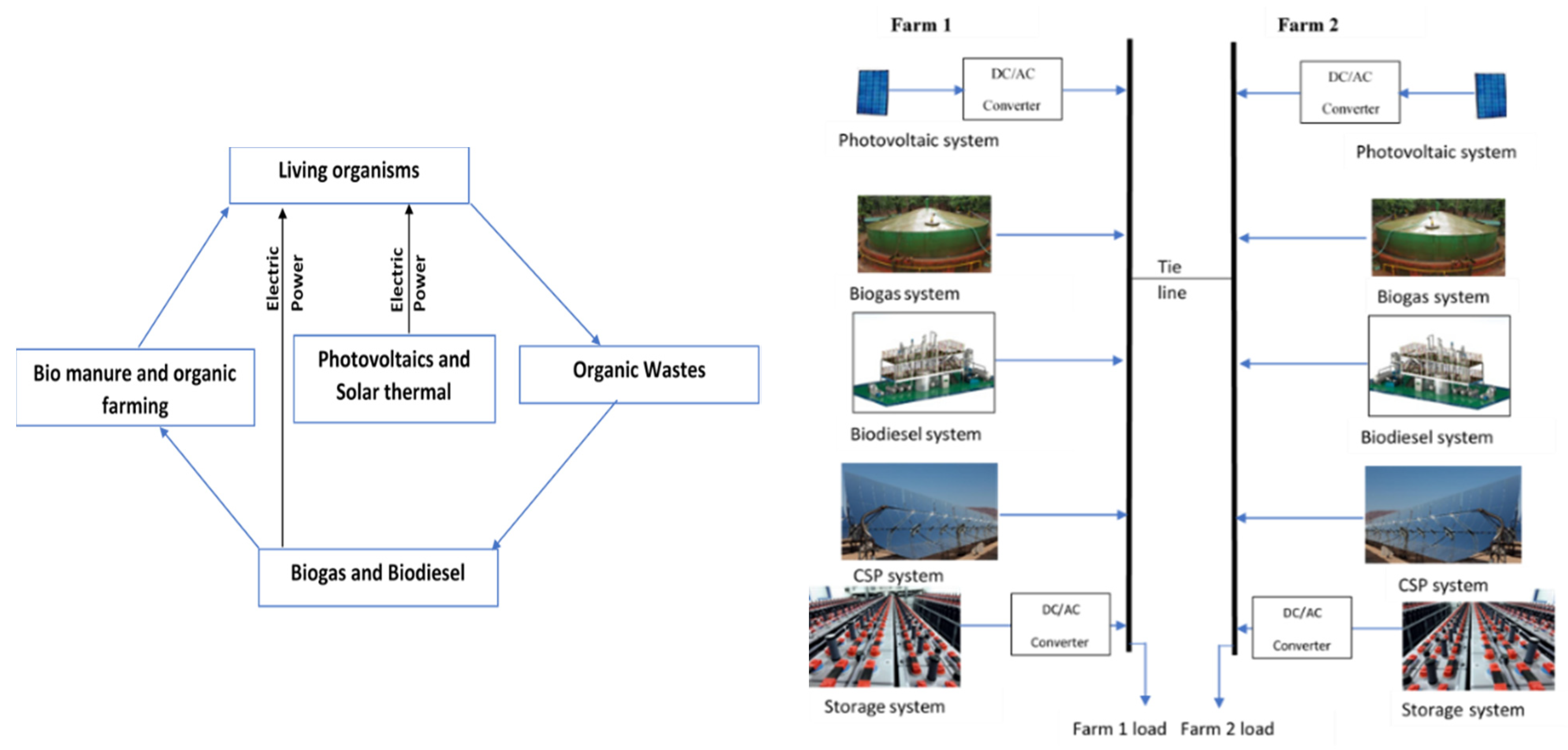
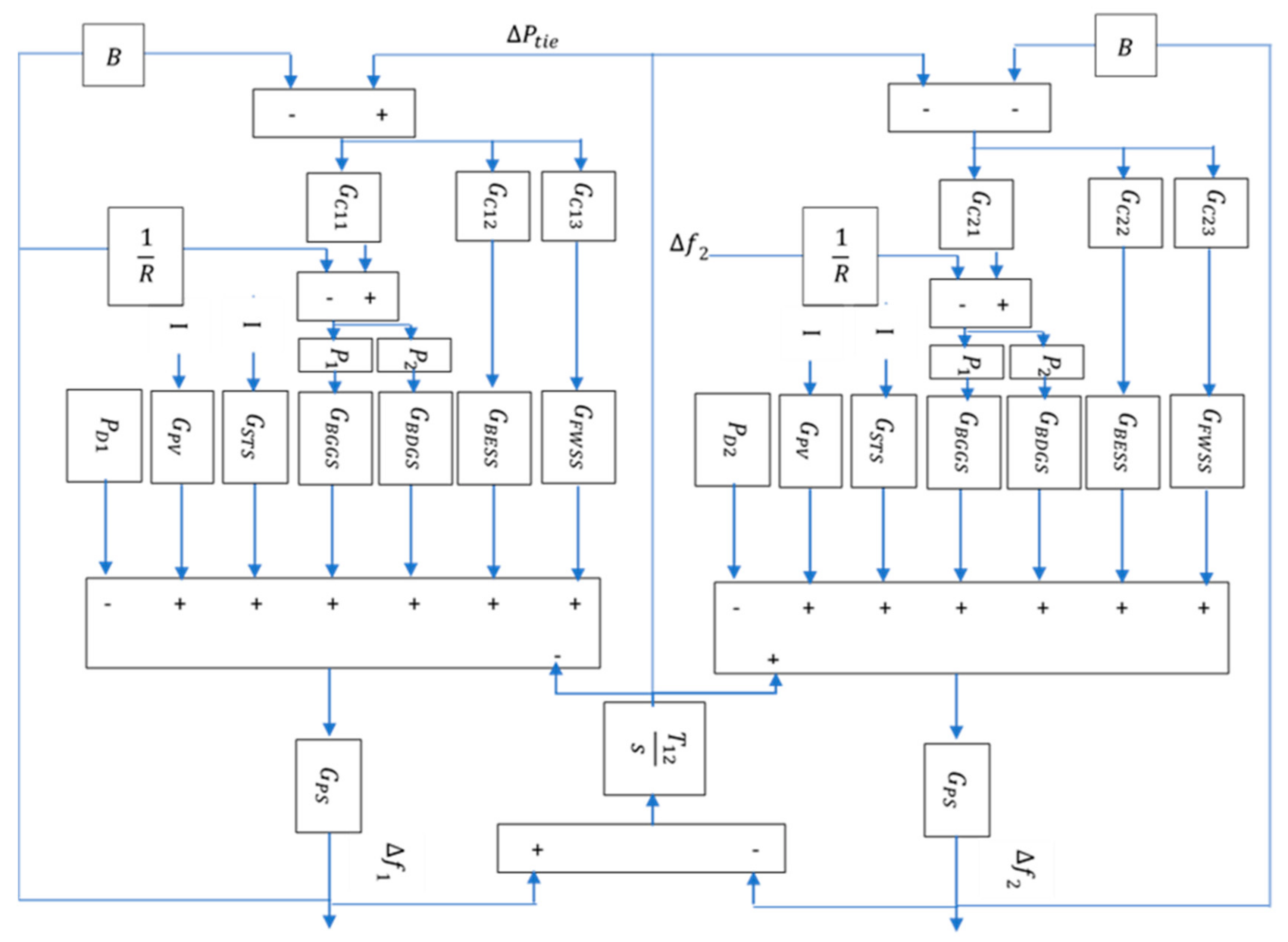
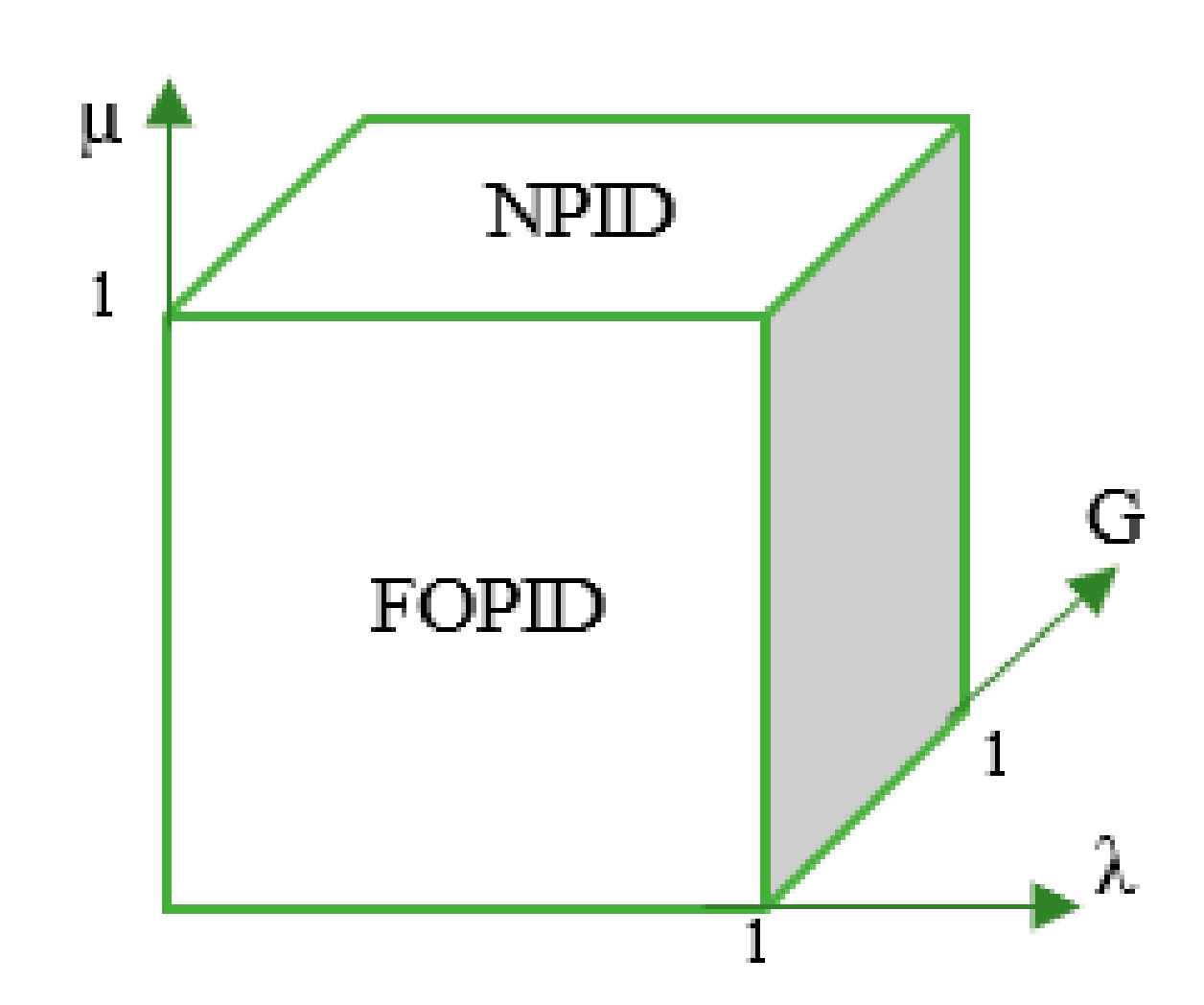

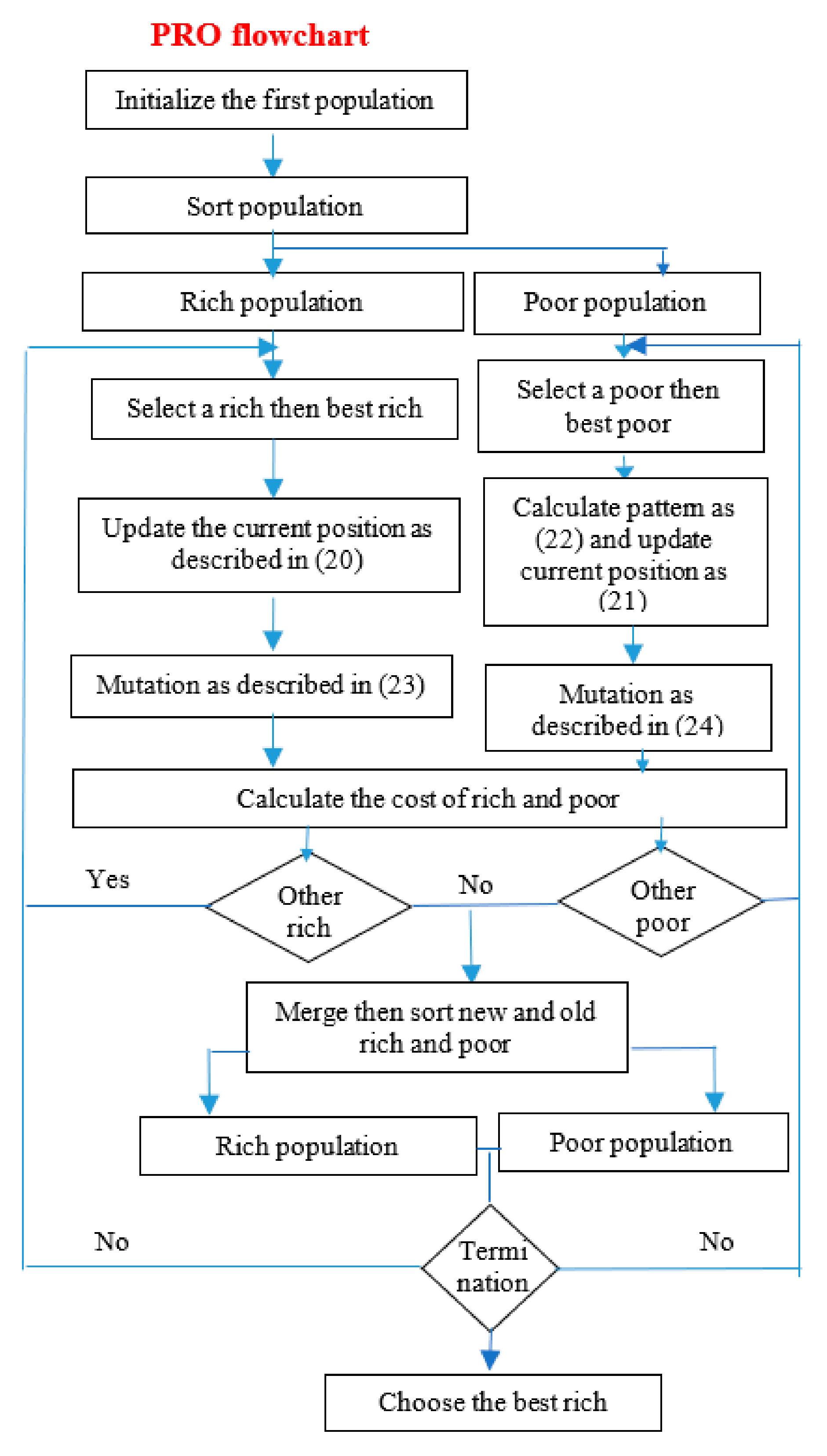
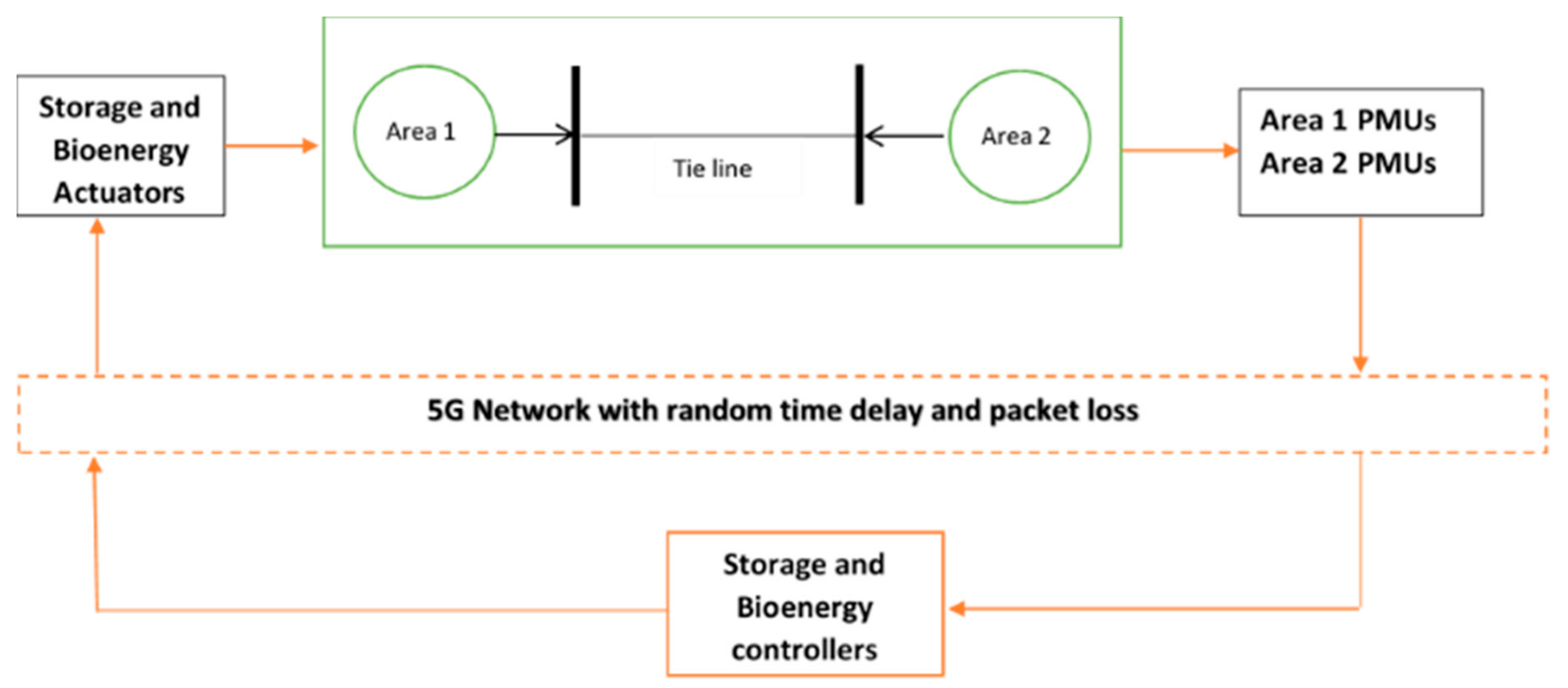

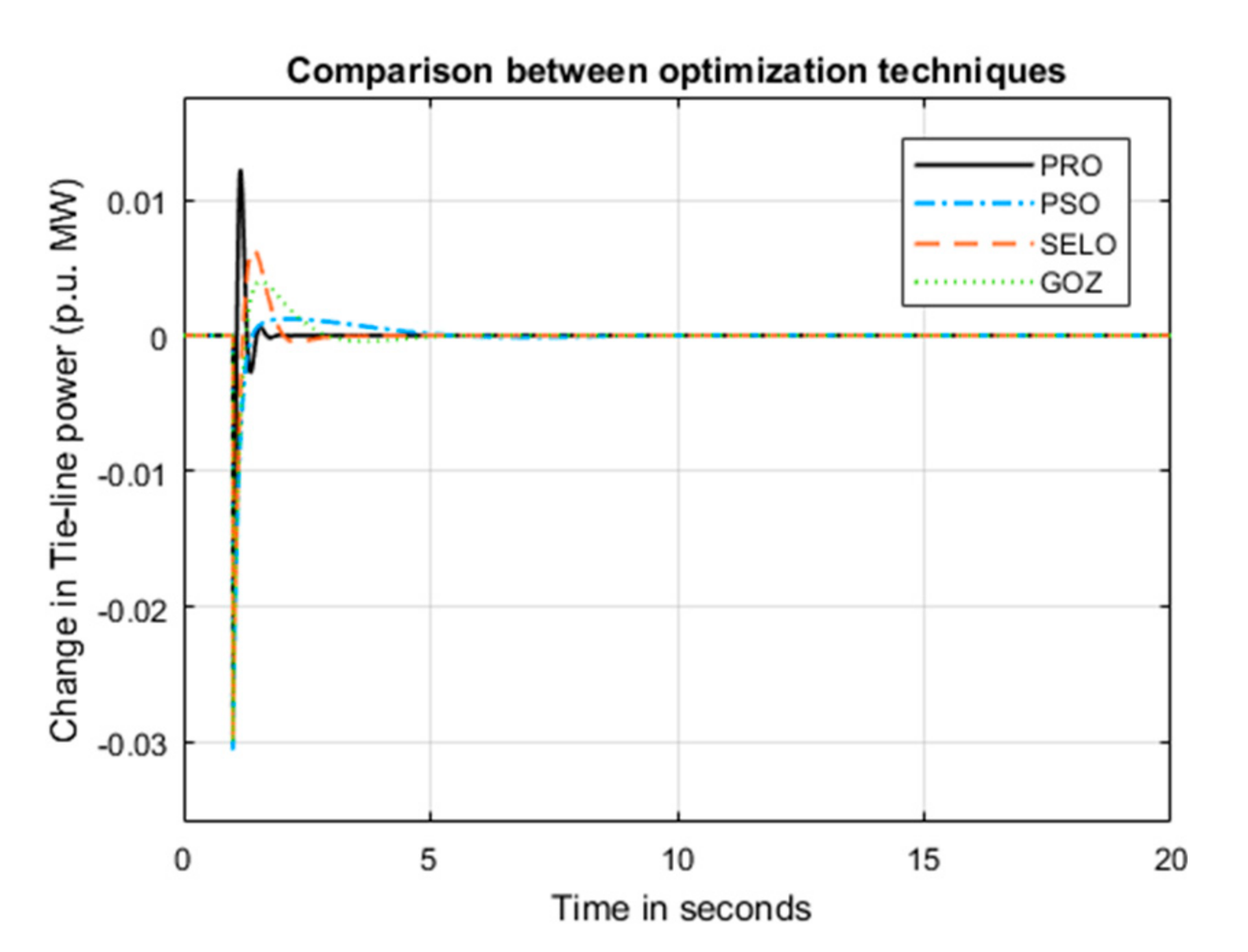
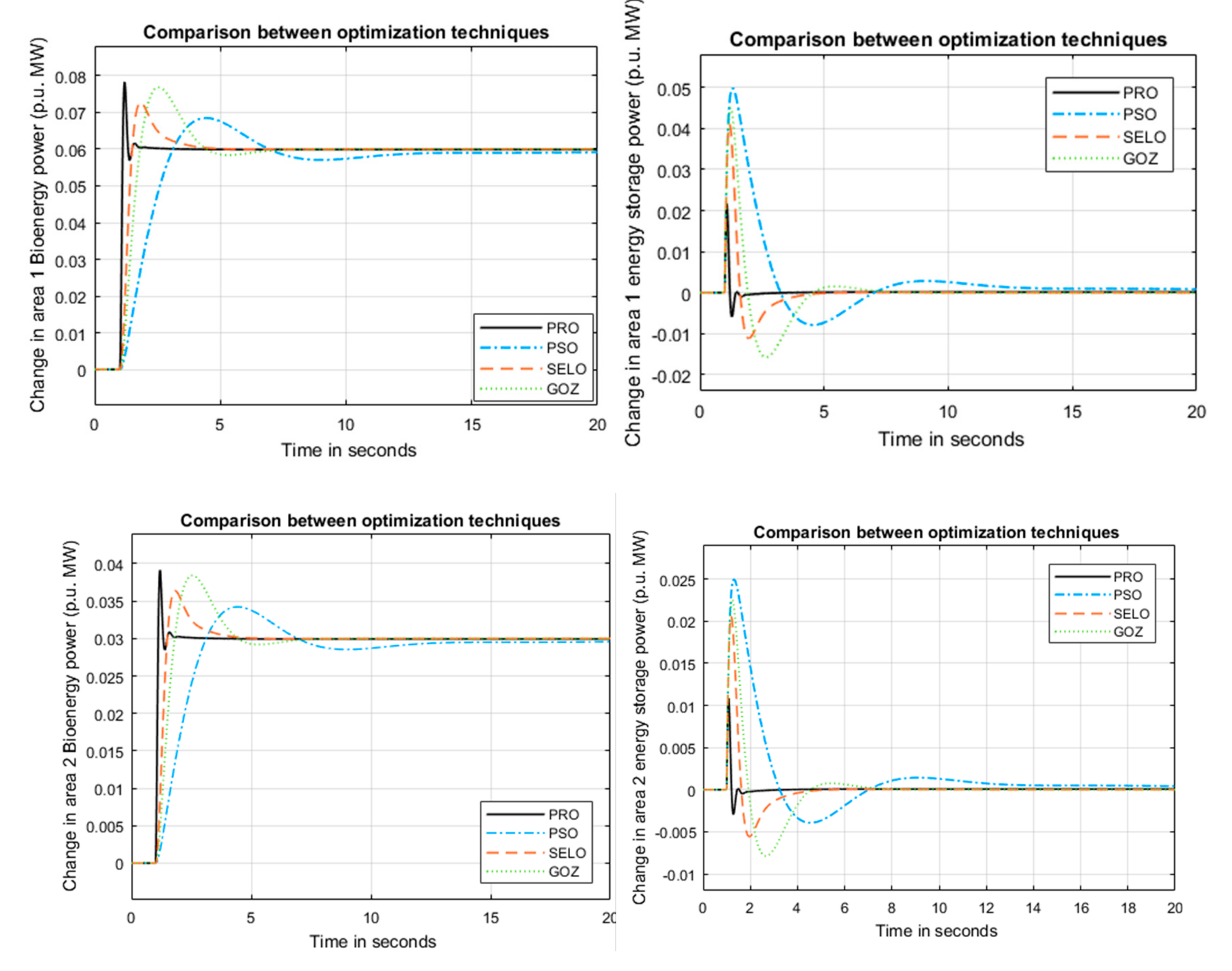
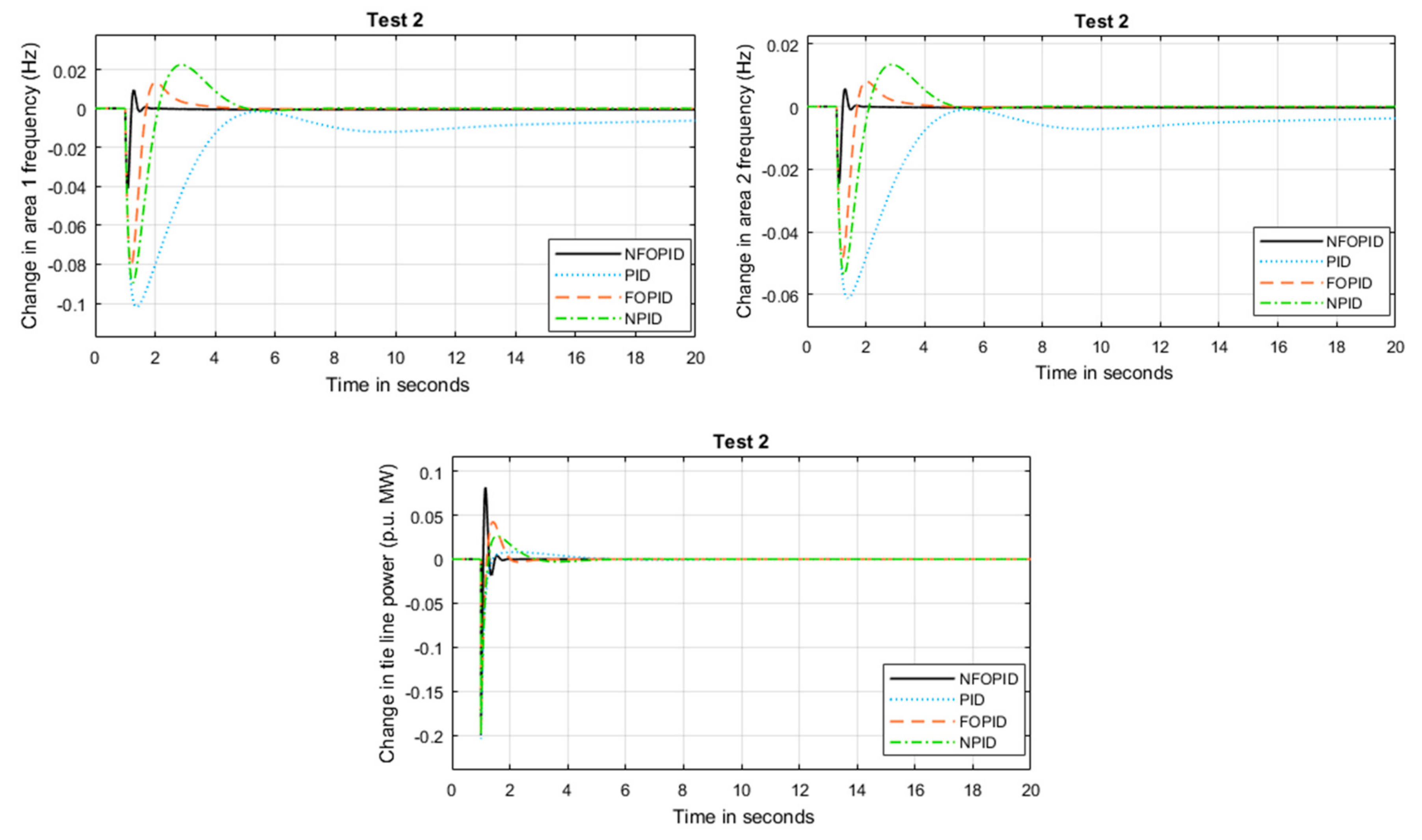
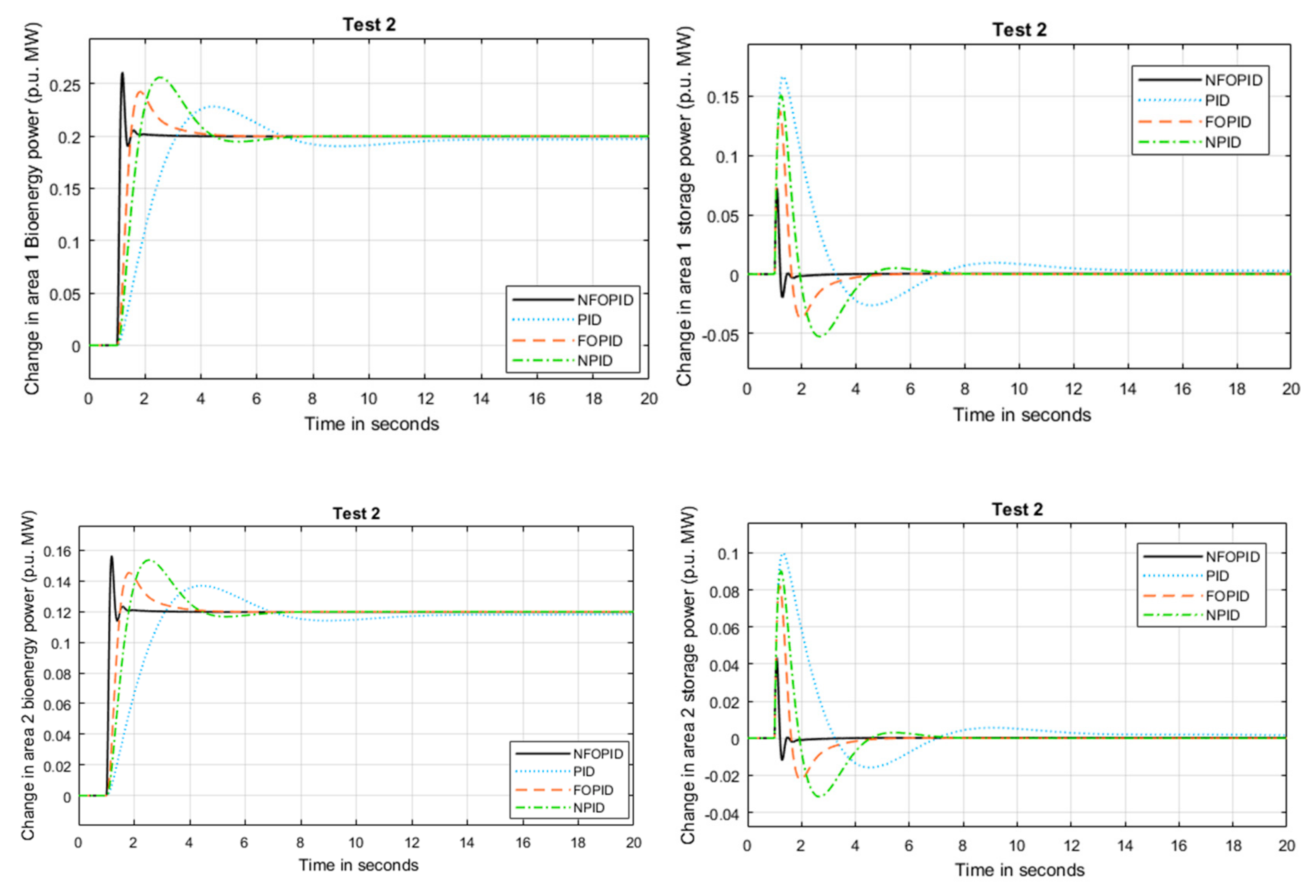
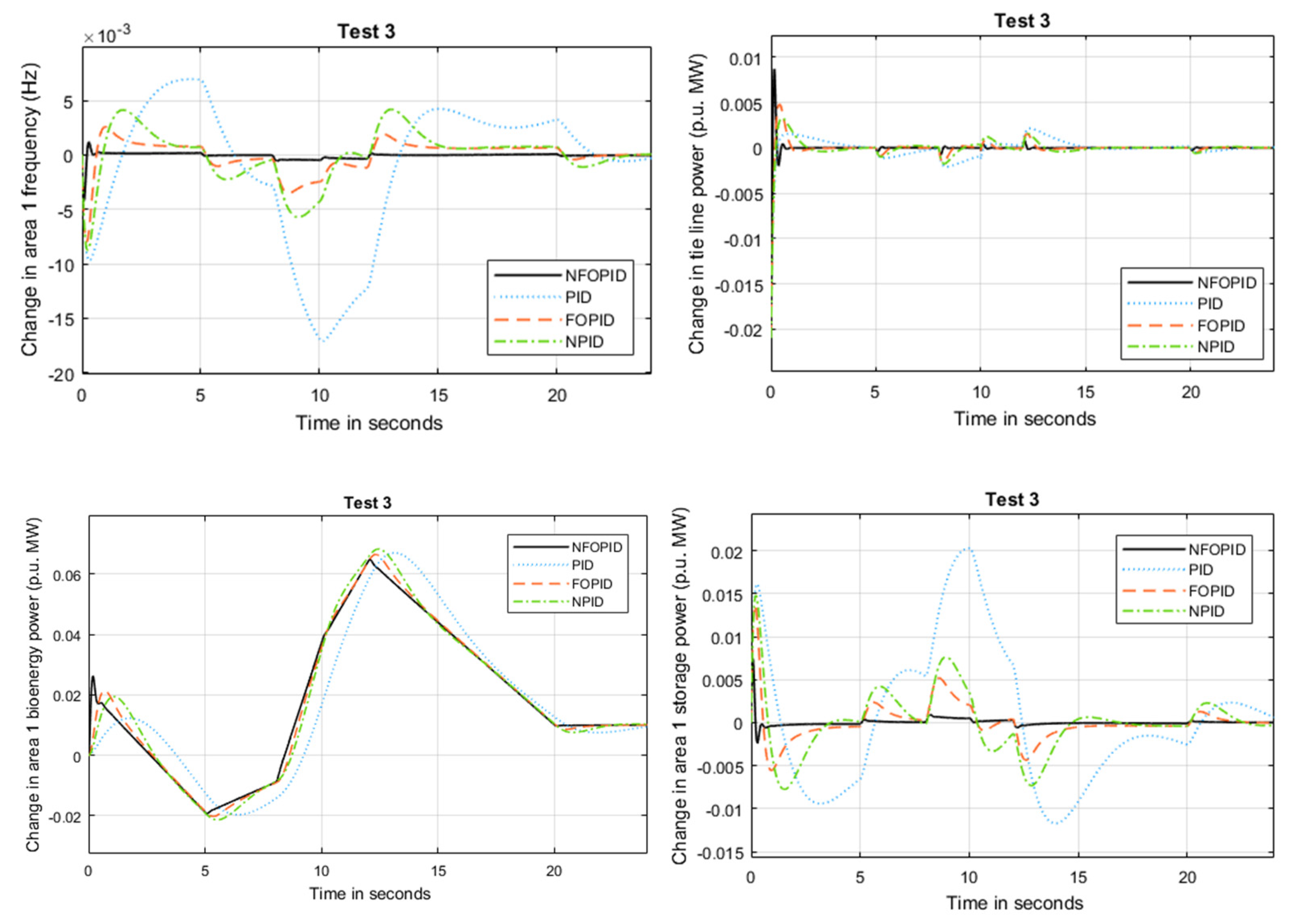
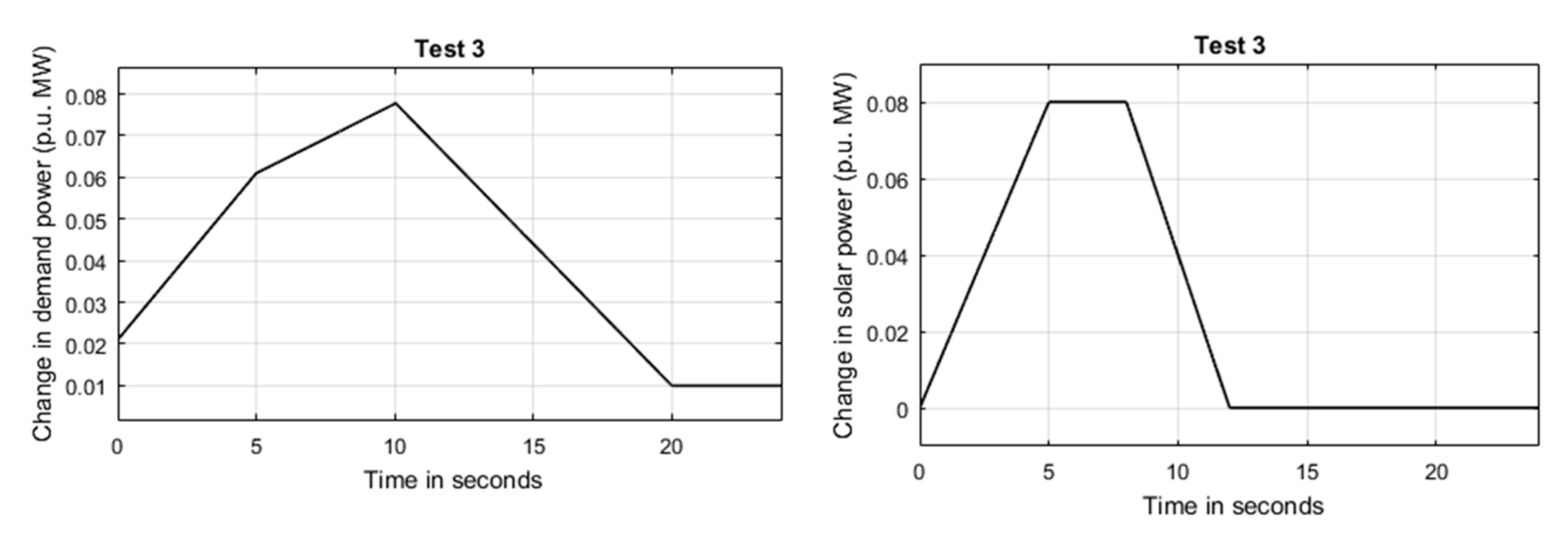

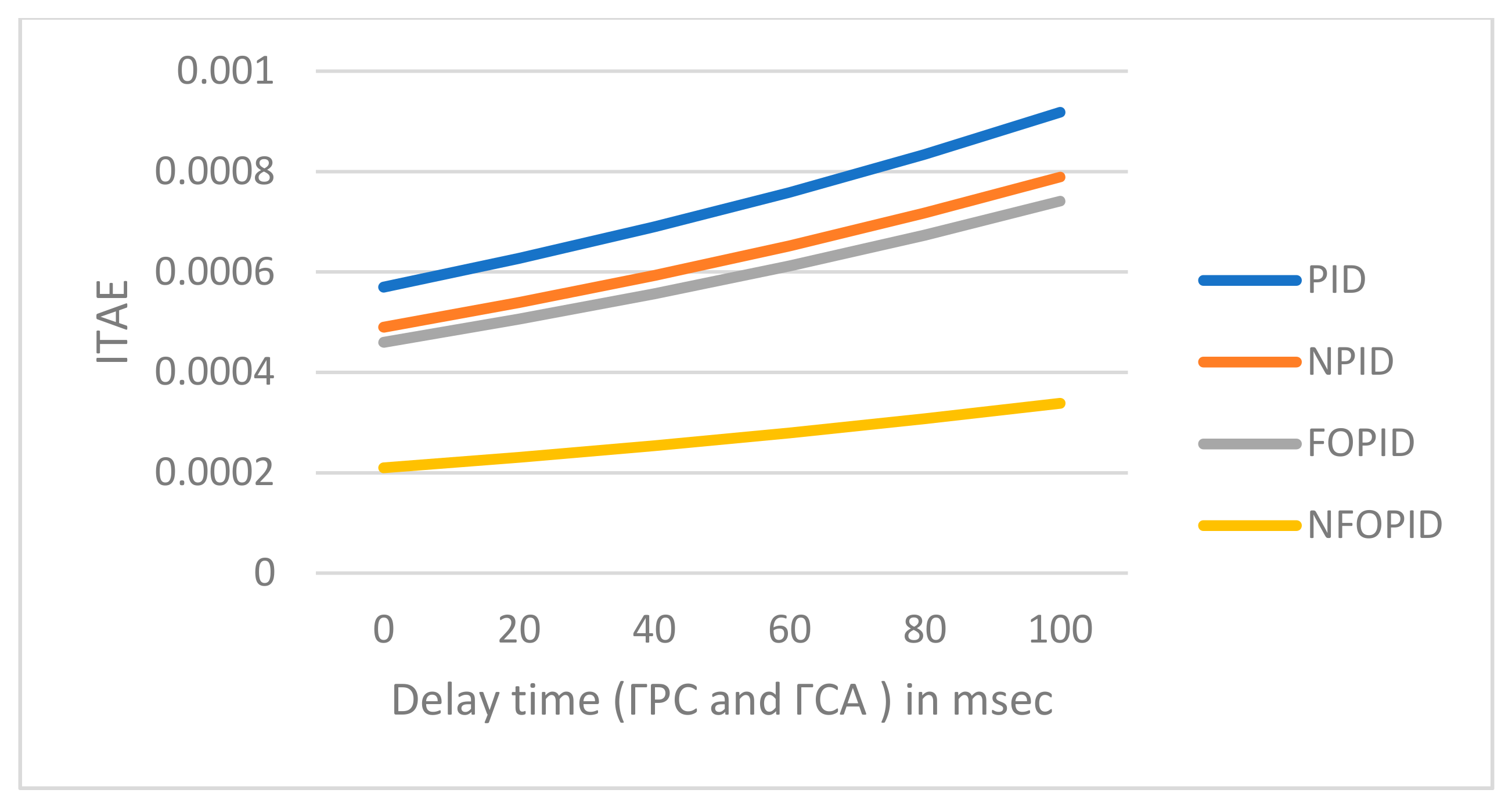

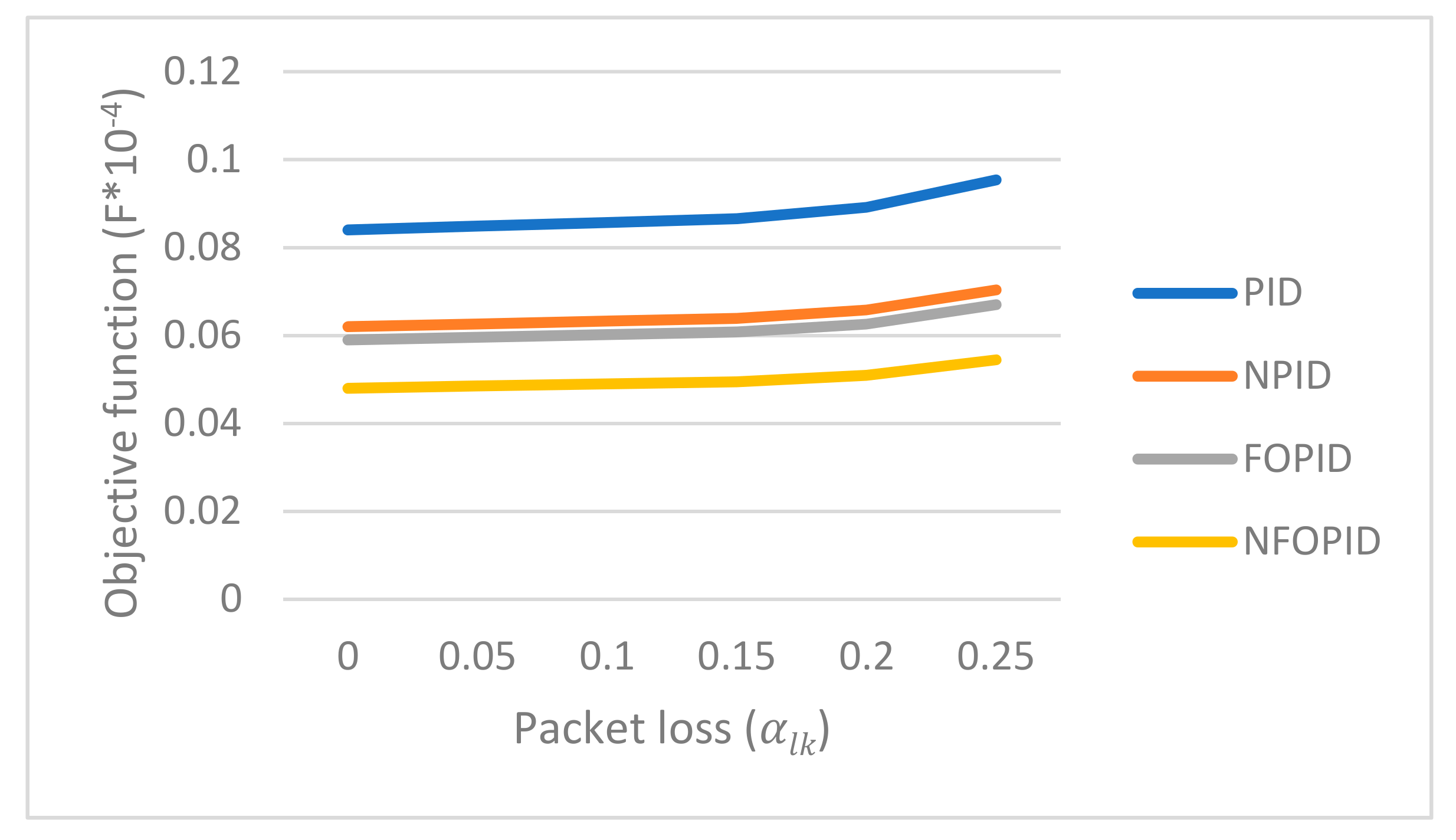

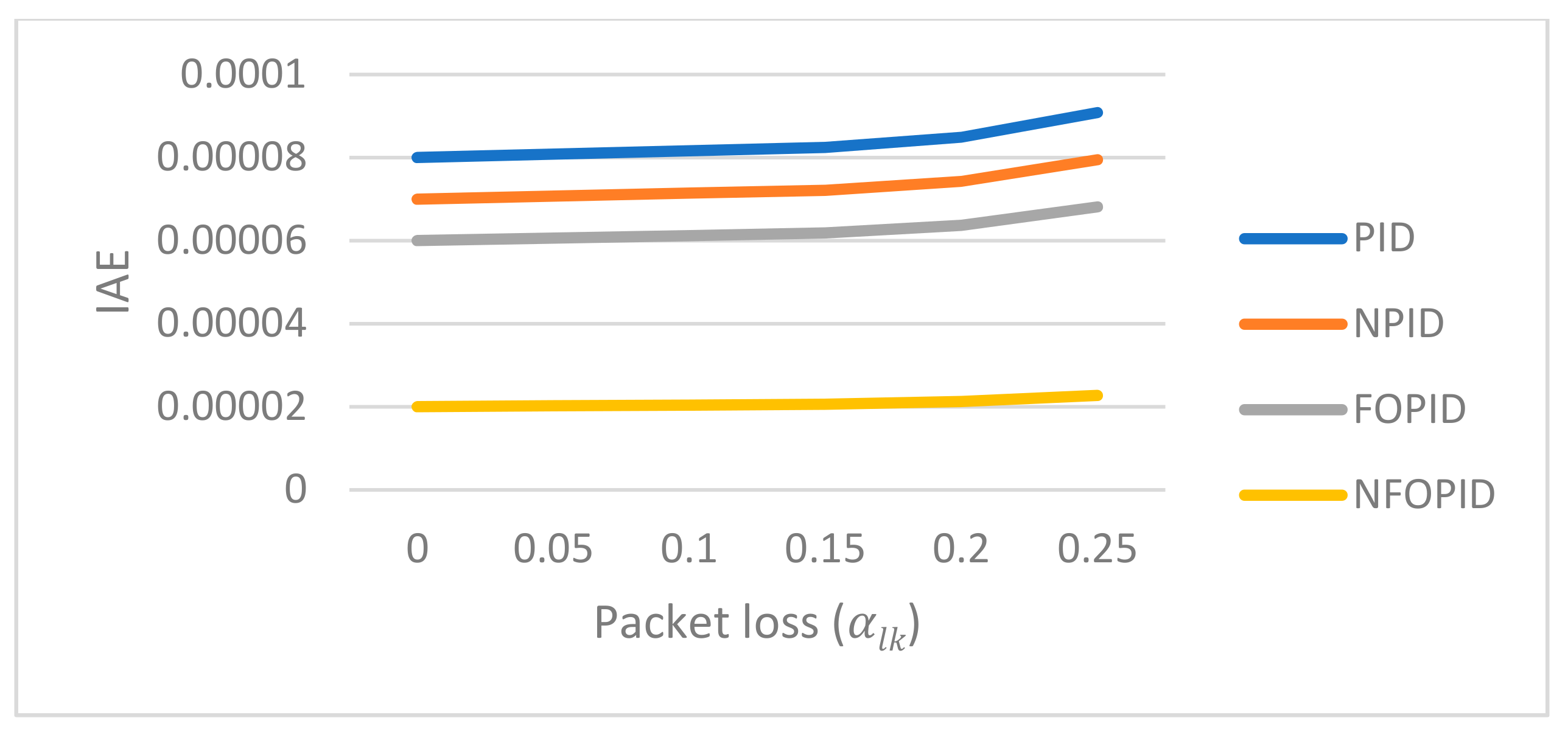
| Parameter | Value |
|---|---|
| 1.8 s | |
| 1 | |
| 0.3 s | |
| 1.8 | |
| 1.8 s | |
| 0.01 | |
| 0.23 s | |
| 0.6 s | |
| 1 | |
| 0.05 | |
| 0.2 s | |
| 1 | |
| 0.05s | |
| 1 | |
| 0.5 s | |
| 0.0033 | |
| 0.1 s | |
| 0.01 | |
| 0.1 s | |
| 0.2 s | |
| D | 0.012 |
| B | 18.4 |
| T12 | 1.9 |
| 0.5 | |
| 0.5 |
| Method | ITAE | IAE | F × 10−4 | Number of Iterations | Transient Response of | Transient Response of | Transient Response of ΔPtie | ||||||
|---|---|---|---|---|---|---|---|---|---|---|---|---|---|
| Ush × 10−3 | Osh × 10−3 | ts | Ush × 10−3 | Osh × 10−3 | ts | Ush × 10−3 | Osh × 10−3 | ts | |||||
| PRO | 0.017 | 0.0033 | 0.39 | 15 | −11 | 2.5 | 2 | −5 | 1 | 2 | −20 | 11 | 2 |
| SELO | 0.019 | 0.0048 | 0.42 | 21 | −24 | 4 | 4 | −11 | 1.5 | 4 | −30 | 6 | 4 |
| GOZ | 0.021 | 0.0057 | 0.48 | 18 | −26 | 7 | 5 | −13 | 2.5 | 5 | −30 | 5 | 5 |
| PSO | 0.026 | 0.0078 | 0.61 | 25 | −30 | 0 | 20 | −15 | 0 | 20 | −30 | 2 | 12 |
| Control Scheme | ITAE | IAE | F × 10−4 | Transient Response of | Transient Response of | Transient Response of ΔPtie | ||||||
|---|---|---|---|---|---|---|---|---|---|---|---|---|
| Ush × 10−3 | Osh × 10−3 | ts | Ush × 10−3 | Osh × 10−3 | ts | Ush × 10−3 | Osh × 10−3 | ts | ||||
| NFOPID | 0.021 | 0.0049 | 0.48 | −40 | 10 | 1.8 | −22 | 5 | 1.8 | −180 | 70 | 1.8 |
| FOPID | 0.032 | 0.0055 | 0.53 | −80 | 15 | 3.7 | −51 | 8 | 3.7 | −200 | 40 | 2.7 |
| NPID | 0.036 | 0.0057 | 0.56 | −85 | 22 | 4.7 | −55 | 12 | 4.7 | −200 | 25 | 3.5 |
| PID | 0.048 | 0.0062 | 0.67 | −100 | 0 | 20 | −60 | 0 | 20 | −200 | 15 | 4 |
| Controller | ITAE | IAE | F × 10−4 |
|---|---|---|---|
| PID | 0.00057 | 0.00008 | 0.084 |
| NPID | 0.00049 | 0.00007 | 0.062 |
| FOPID | 0.00046 | 0.00006 | 0.059 |
| NFOPID | 0.00021 | 0.00002 | 0.048 |
Publisher’s Note: MDPI stays neutral with regard to jurisdictional claims in published maps and institutional affiliations. |
© 2020 by the author. Licensee MDPI, Basel, Switzerland. This article is an open access article distributed under the terms and conditions of the Creative Commons Attribution (CC BY) license (http://creativecommons.org/licenses/by/4.0/).
Share and Cite
Fayek, H.H. 5G Poor and Rich Novel Control Scheme Based Load Frequency Regulation of a Two-Area System with 100% Renewables in Africa. Fractal Fract. 2021, 5, 2. https://0-doi-org.brum.beds.ac.uk/10.3390/fractalfract5010002
Fayek HH. 5G Poor and Rich Novel Control Scheme Based Load Frequency Regulation of a Two-Area System with 100% Renewables in Africa. Fractal and Fractional. 2021; 5(1):2. https://0-doi-org.brum.beds.ac.uk/10.3390/fractalfract5010002
Chicago/Turabian StyleFayek, Hady H. 2021. "5G Poor and Rich Novel Control Scheme Based Load Frequency Regulation of a Two-Area System with 100% Renewables in Africa" Fractal and Fractional 5, no. 1: 2. https://0-doi-org.brum.beds.ac.uk/10.3390/fractalfract5010002





